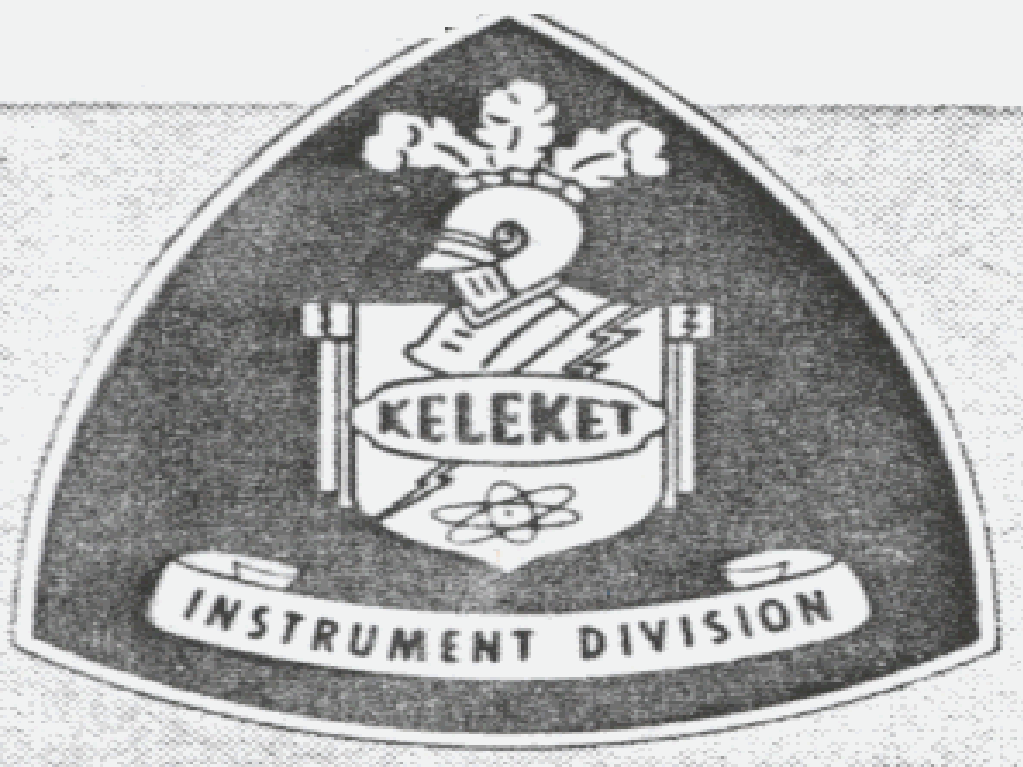
Kelley-Koett Manufacturing Company
The Kelley-Keott Manufacturing Company was located at 212 West Fourth Street in Covington, Kentucky in 1949. It was founded by John Kelley and Albert Koett. In 1950, it was located at 125 East 6th Street. In 1950, they relocated to 966-10 York Street, Cincinnati, Ohio. It was advertised as the “Leading Manufacturer of Instruments for the Atomic Age”. In 1948, they announced the “Keleket” Instrument Division for the production of high quality instruments for the detection of radiation. They also claim to be manufacturers of fine x-ray equipment since 1900. Later in mid-1950, the company moved to 16-6 E. Sixth Street. The company was purchased by Tracerlab in 1951.

Keleket Instrument Division Logo

Kelley-Koett Logo 1949

Kelley-Koett Logo 1949

Kelley-Koett Logo 1950
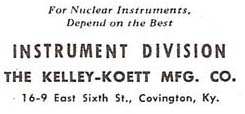
Kelley-Koett Logo 1950

Kelley-Koett Logo 1950

Kelley-Koett Logo 1951
The K-320 is a portable survey meter for alpha, beta and gamma radiation introduced in 1949. It has a sensitive quartz fiber electrometer for accurate measurements for ranges to 100 and 1,000 mR/h. It has an integrating air ionization rate meter internal to the instrument. It is an improved version of the original Landsverk-Wollan survey meter developed by the Manhattan Engineer District, predecessor to the Atomic Energy Commission (AEC). It has a cellulose acetate beta window and a nylon alpha window. It weighs 4 lbs.
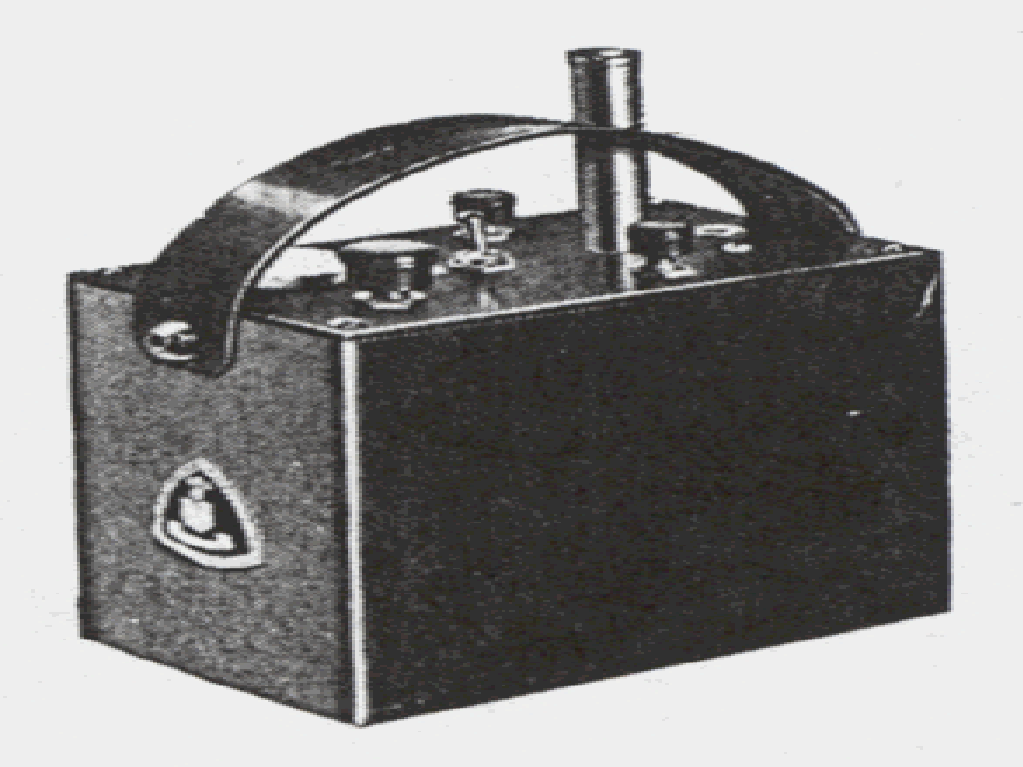
Kelley-Koett Model K-320 1949
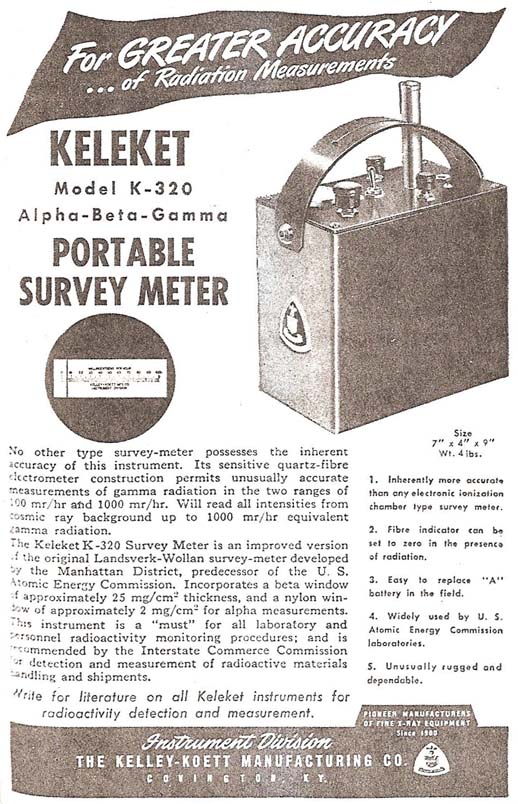
Keleket Model K-320 Ad 1949
The Model K-340 “Hanford Zeuto” was introduced in 1948 as the commercial version of the original Hanford Zeuto alpha survey meter. It was designed for alpha surface contamination measurements. The ionization chamber volume is 27 cubic inches. It has a 3” x 5” nylon window. The range is 5,000, 50,000, and 500,000 dpm. There is no discrimination between alpha and beta. It has two time constants - 2 seconds and 7 seconds (most sensitive). It has a 0-5 meter with 10 major divisions. The unit is 9.5” x 6” x 5” and weighed 6 lbs.
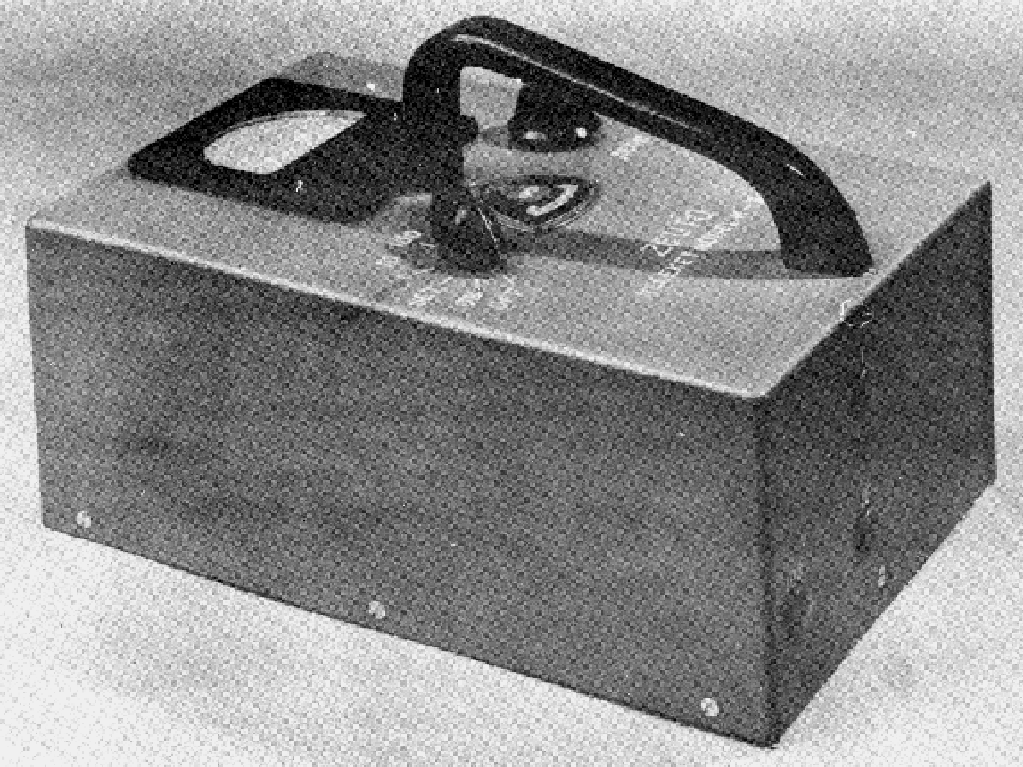
Kelley-Koett Hanford Zeuto Model K-340 1948
The Kelly-Koett Model K-350 was introduced in 1948 and was designated AN/PDR-T-1W and built for the military Signal Corps. It was the first ion chamber gamma survey meter built to military specifications. The unit is rugged, sealed and can operate to 35,000 feet in aircraft. It has a light on the large 4-inch meter scale. Its new feature was automatic scale changing. As the range switch is rotated, only one easy-to-read scale, each differently colored, is visable. The scales have different colored backgrounds to facilitate distinction. For night operations, the meter has a light controlled button on the handle. The scale colors are 50 R/h (light magenta), 5 R/h (orange), 0.5 R/h (yellow), 0.05 R/h (white) and 0.005 R/h (green-yellow). It had time constants of 8 seconds for 5 mR/h, 5 second for 50 mR/h and 2 seconds for the other scales. It could operate in up to 100% humidity and was immersion proof. It had ranges from 5, 50, 500, 5000, and 50,000 mR/h. The unique scale changing meter shows only one range visible at a time. It is an air ionization chamber at atmospheric pressure with volume of 54 cubic inches. It is 10” x 6” x 7.5” and weighs 10 lbs. It was welded steel with baked olive drab enamel and has a contamination resistant “hammertone” finish. This unit was also manufactured by Tracerlab.
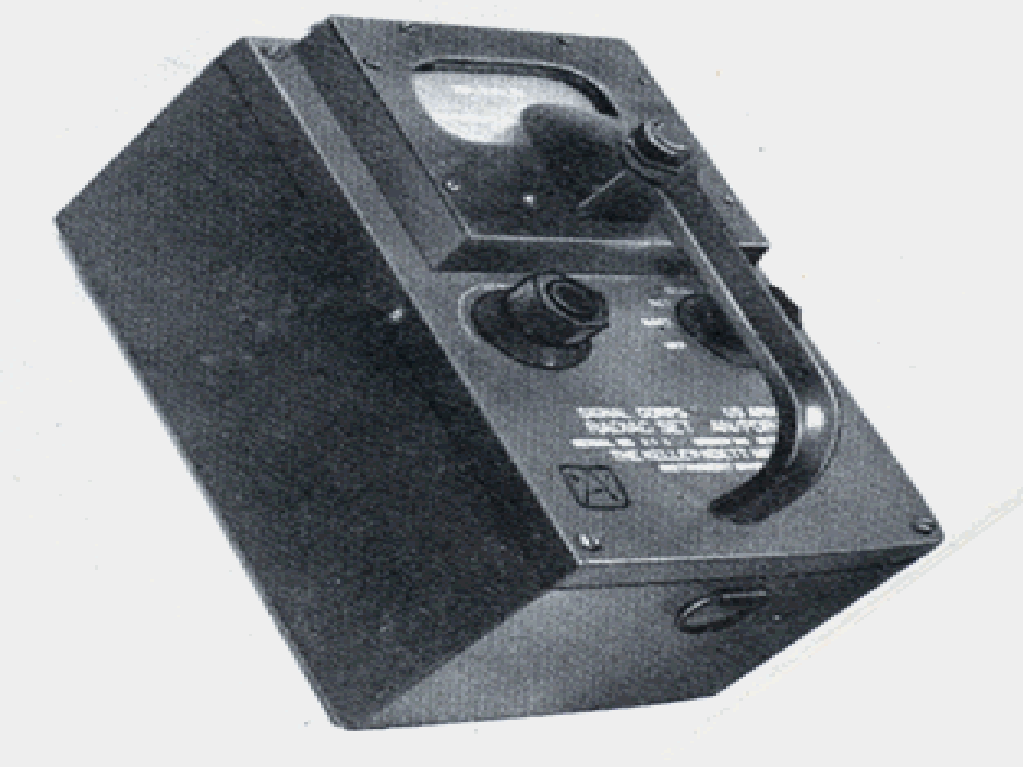
Kelley-Koett Model 350 (AN/PDR-T-1) 1948
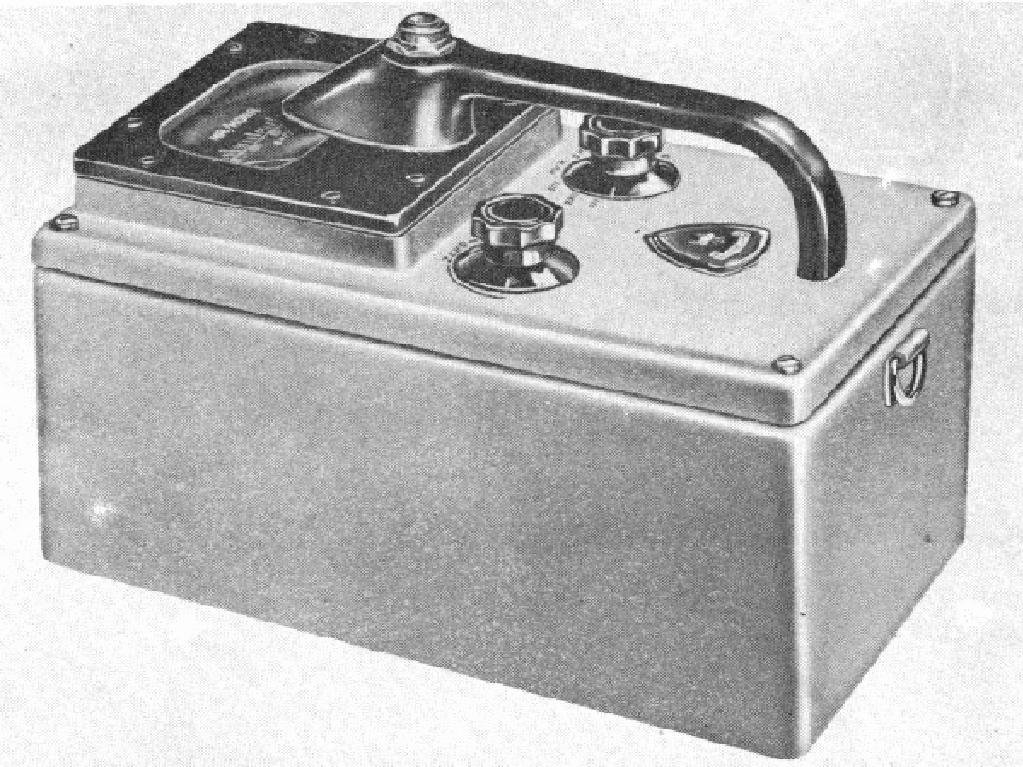
Keleket Model K-350 1949
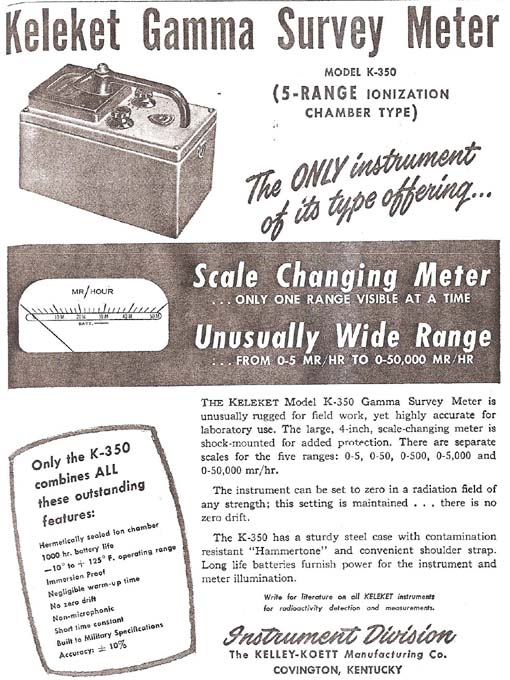
Keleket Model K-350 Ad 1949
The Model K-351 was produced in 1950. The unit is similar to the Model K-350 which was designed to rigid specifications of the Signal Corps. The K-351 has the added advantage of providing detection of alpha and beta radiation. A very thin window of rubber hydrochloride has been placed on the bottom of the ion chamber to pass alpha, beta and low energy x-rays. It has metal grill to protect from damage. A snap on metal shield is provided to stop alpha and beta radiation when gamma radiation measurement is required. This feature also allows it to be “immersion-proof”. It was designed for checking contamination and personal protection. It had ranges of 0-500,000 dpm alpha and 0-50,000 mR/h gamma based on radium gammas. The ion chamber has 1/8” plastic walls and is graphite coated. The alpha window is pliofilm. It has a grey hammertone finish and weighs 10 lbs.
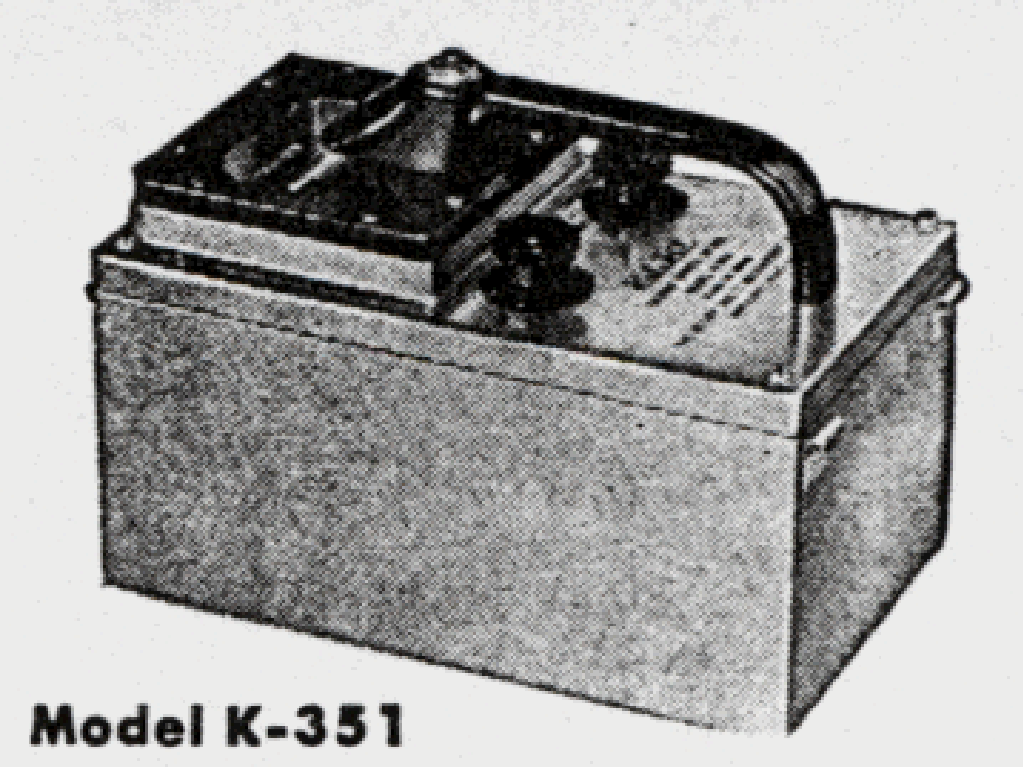
Keleket Model K-351 1950
The Model K-352 Cutie Pie is an ionization chamber for detecting alpha, beta and gamma radiation. It was introduced in 1950. The unit is an improved version of the Oak Ridge National Laboratory Cutie Pie instrument. It has three decade ranges from 50-5,000 mR/h based on radium gamma. The ion chamber is 3” diameter and 6” long paper-based bakelite tubing with aquadag inner coating. It has a pliofilm thin window allowing detection of high energy alpha and beta. It uses one 1.5 and four 22.5 volt batteries stored in the pistol grip handle. Battery section come apart from main unit for ease of battery replacement. It comes in a welded aluminum case. It measures 11” x 3.25” x 8” and weighs 2.5 lbs.
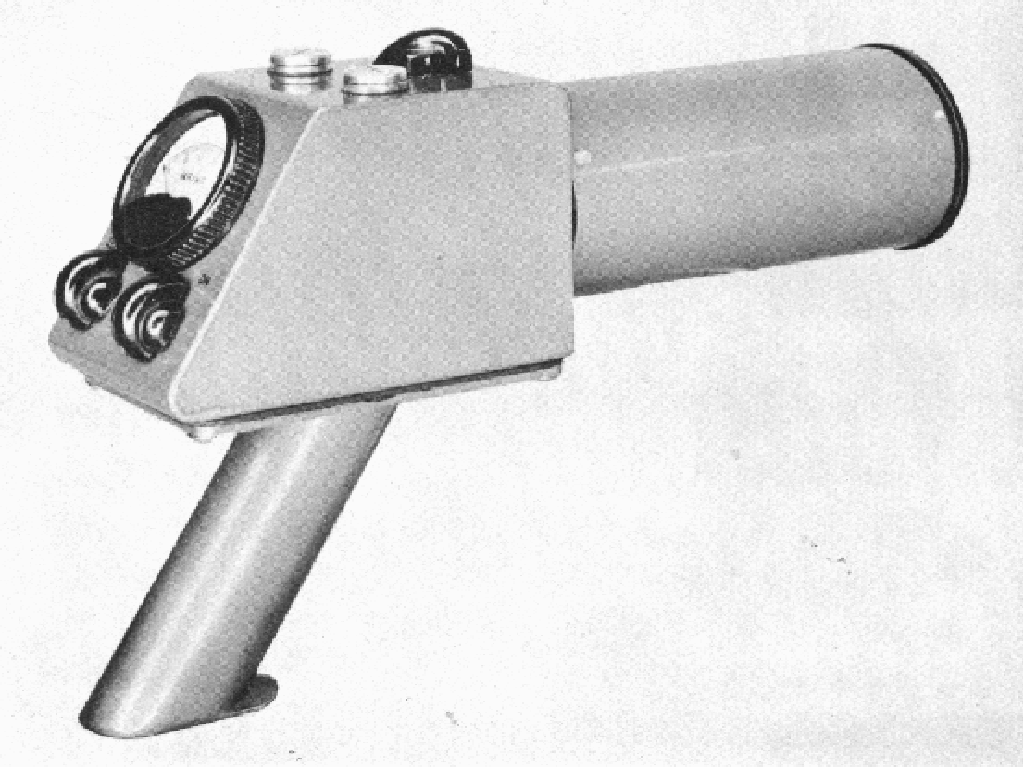
Keleket Model K-352 Cutie Pie 1950
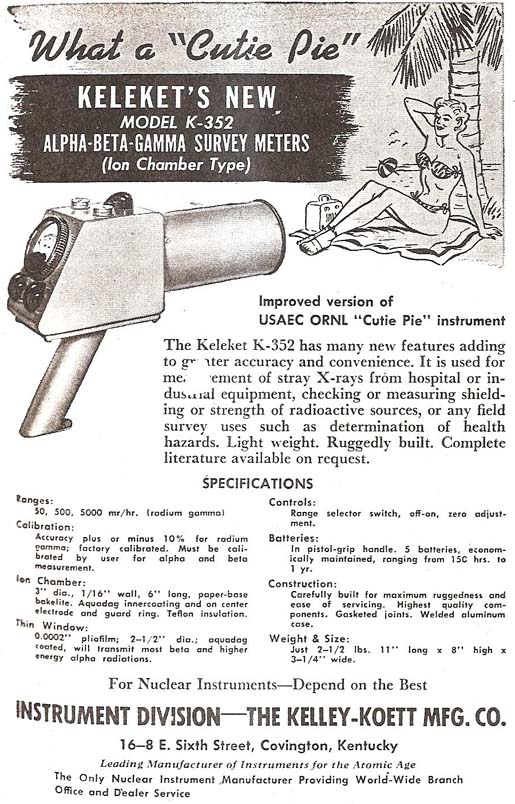
Keleket K-352 Cutie Pie Ad 1950
The K-800 was a portable beta-gamma radiation survey meter available in 1949. It had a thin wall glass GM tube. The three decade range was from 0.2 to 20 mR/h and also calibrated in three decades from 360-36000 cpm scale observable on a 2.5” meter. It had a model K-23 GM tube of aluminum casing. The unit was lightweight, 10 lbs, immersion proof, and made of stainless steel. The probe had a 30” self-retracting cord and a moveable beta shield. The unit has a convenient “coil-cord” on probe. It used one 1.5V, one 67.5V and three 300V batteries. It weighed 8 lbs. It sold for $250 in 1950. It was housed in rugged cast aluminum with a Kelegrey hammertone smooth enamel finish which aid in decontamination.
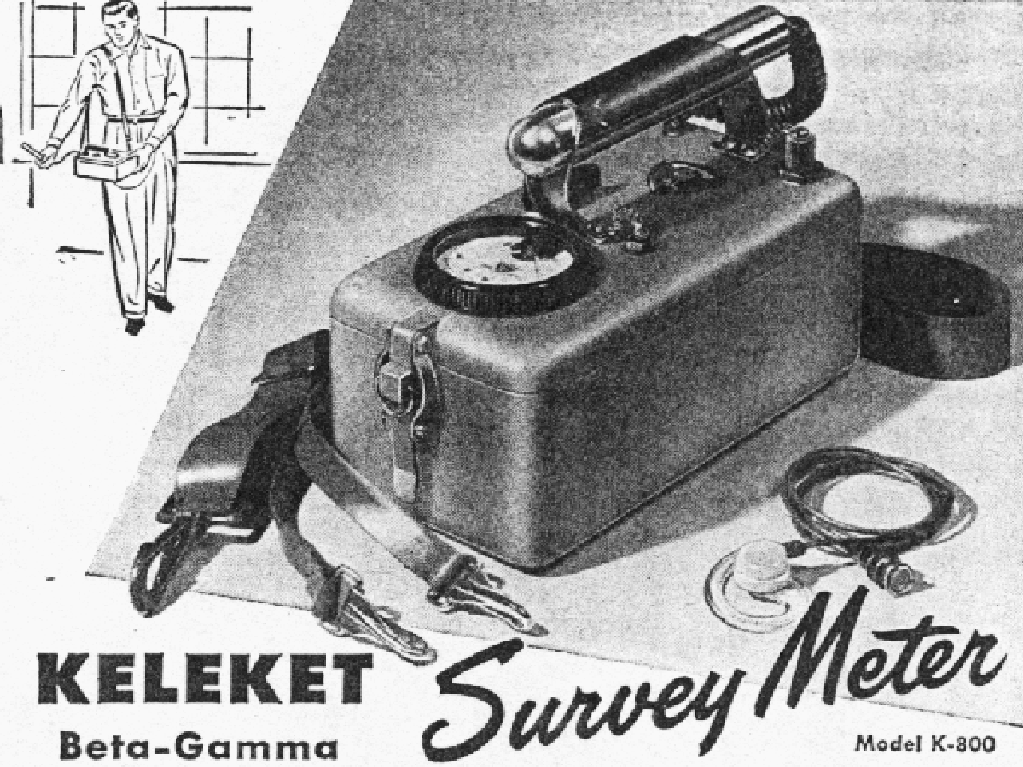
Keleket K-800 1949
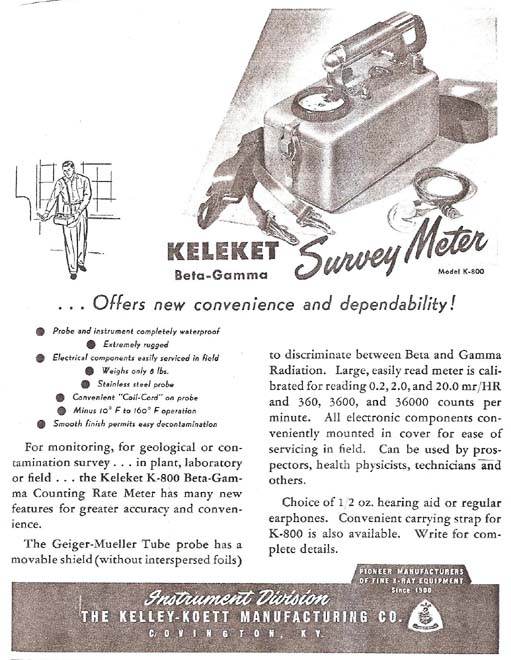
Keleket Beta-Gamma Survey Meter Ad 1949
The Keleket Model K-802 “Prospector” was offered in 1949 for $48.50. It was a simple to operate, lightweight prospecting instrument. It came complete with headphones and provided an easy approach to detect uranium. It is sensitive to beta and gamma by an internal probe. Two flashlight batteries power the vibrating power supply for 50 hours. It can be used for prospecting or locating lost radium needles. The unit is 6.5” x 3.75”x 2.25” and weighs 2 lbs. The case is plastic. The unit can be purchased with the K-812 demonstration amplifier for audible demonstrations of nuclear radiation.
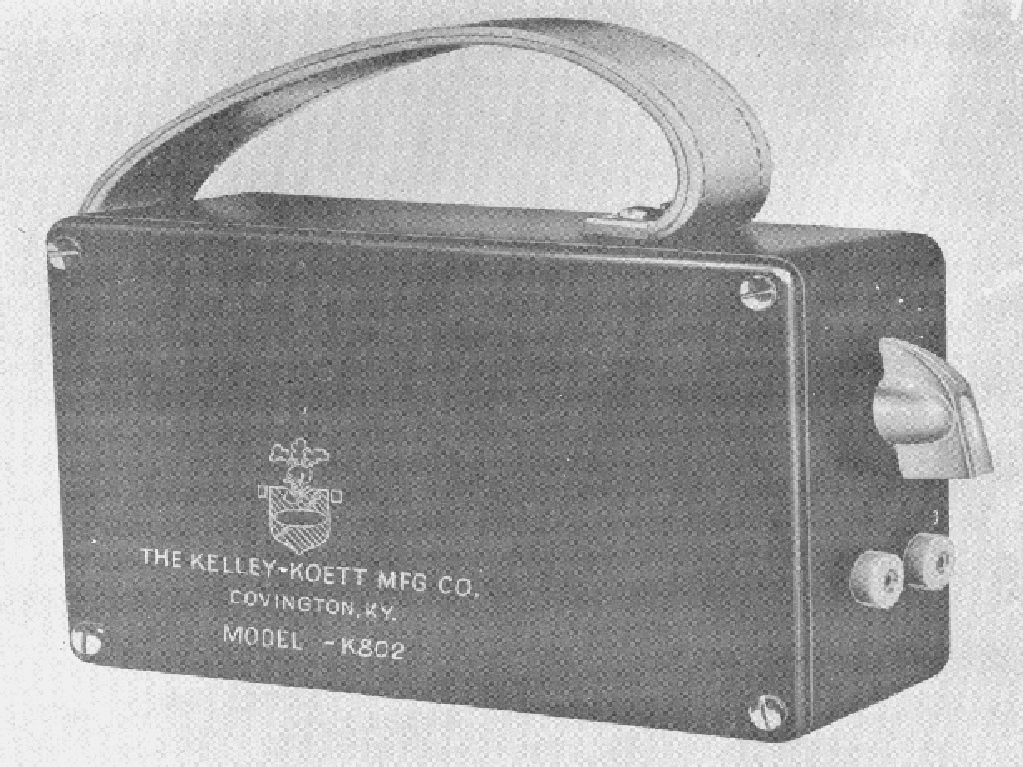
Keleket Model K-802 Prospector 1949
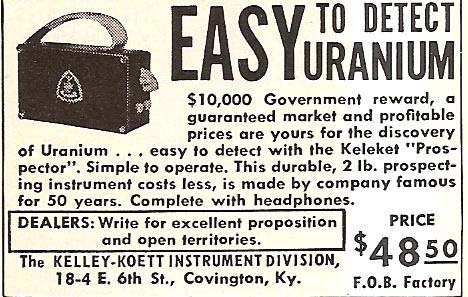
Keleket Model K-802 Prospector Ad 1950

Keleket K-802 Prospector Ad 1949
The Model K-803 was introduced in 1950 as a survey meter for beta gamma detection. This unit could be connected to a P.A. system for classroom demonstrations.
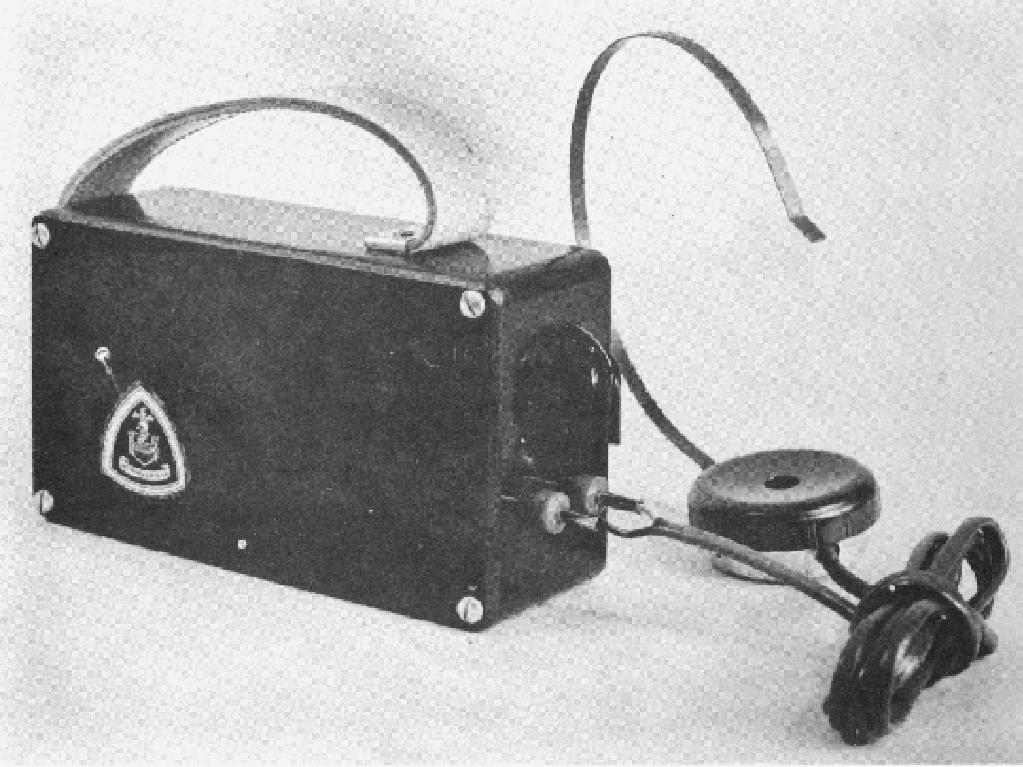
Kelley-Koett Model K-803 1950
The K-900 demonstration unit was introduced in 1949 as a “Radioactivity Demonstrator” for classroom and lectures. It has a thin wall geiger tube on a three-foot retractable cord. It could detect both beta and gamma. Scale was in cpm and mR/h. It provided both visual and audio indicators. The unit has an external probe for beta gamma detection. It has adjustable high voltage from 600-1200 volts allowing use of a variety of probes. This allows for plotting the plateau values for probes. It operated on 110 volt AC power. It was 12” x 6” x 7” and weighed 12 lbs.
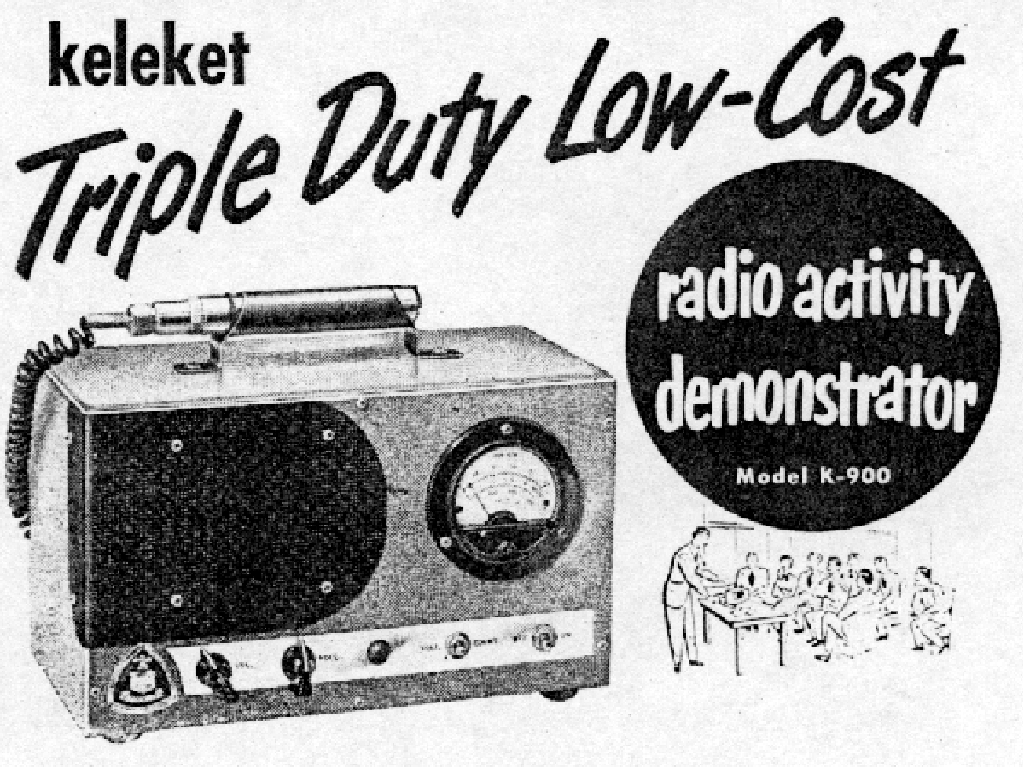
Keleket Radioactivty Demonstrator 1949
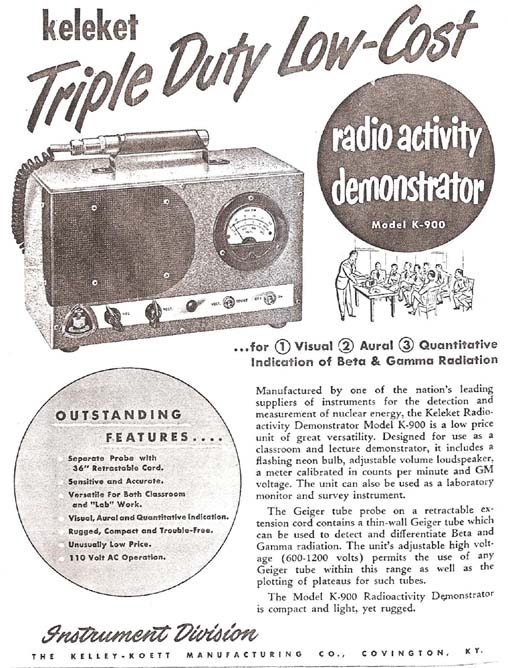
Keleket Radioactivity Demonstrator Model K-900 Ad 1949
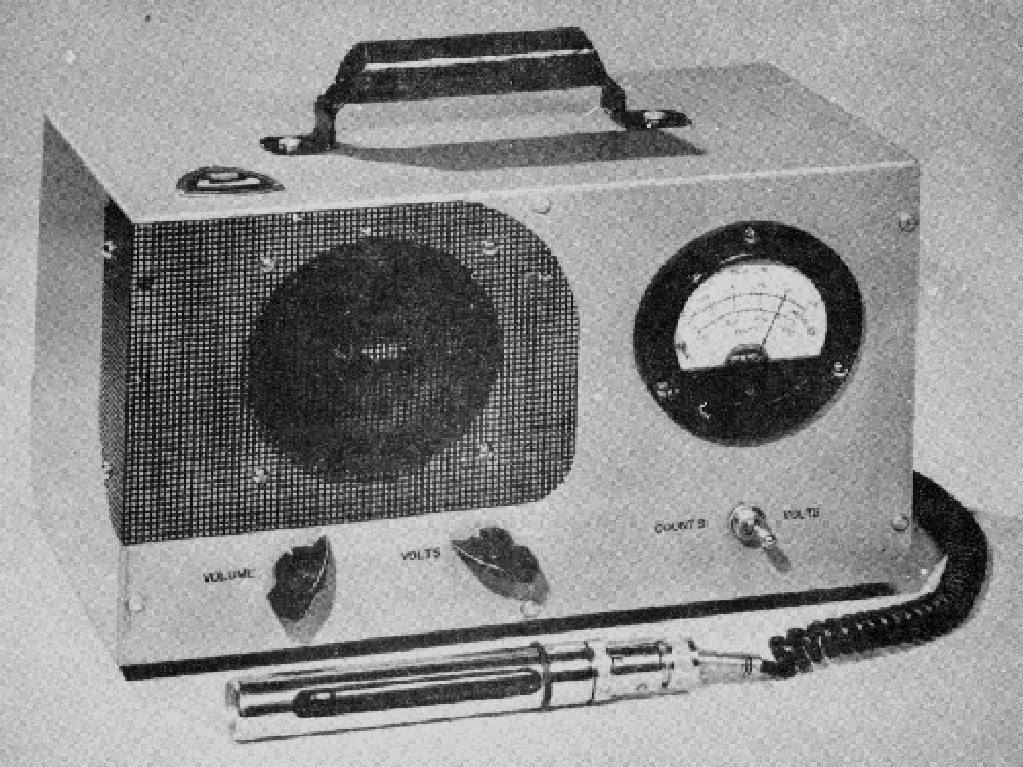
Kelley-Koett Model K-900 1950
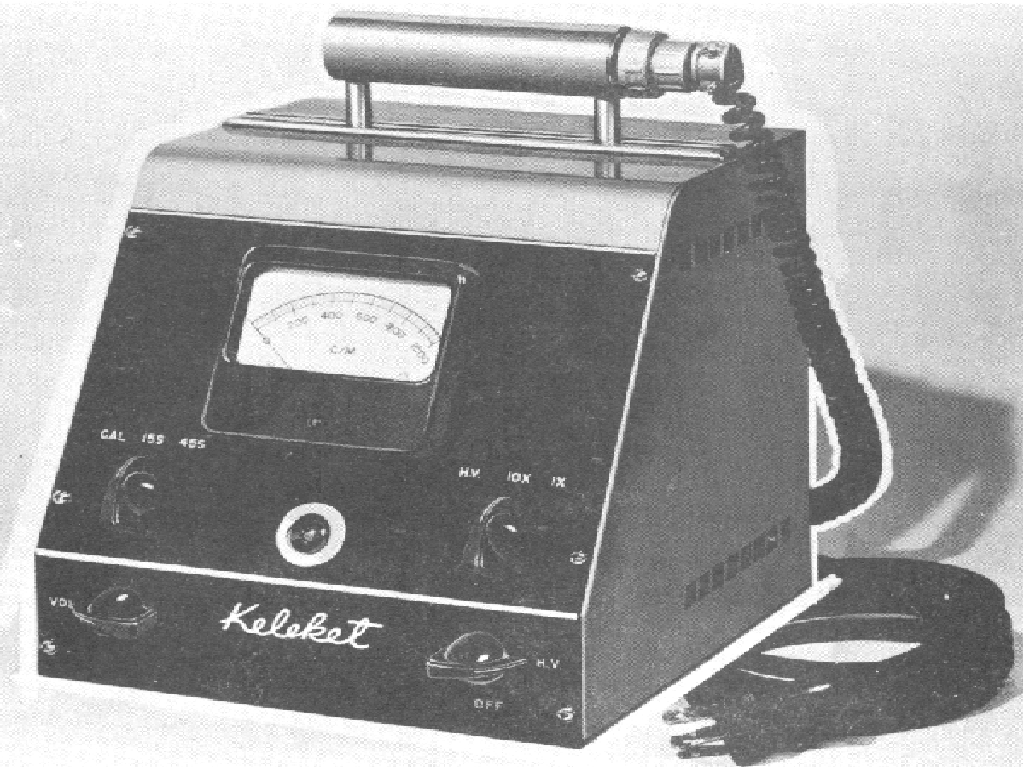
Kelley-Koett K-900 1950
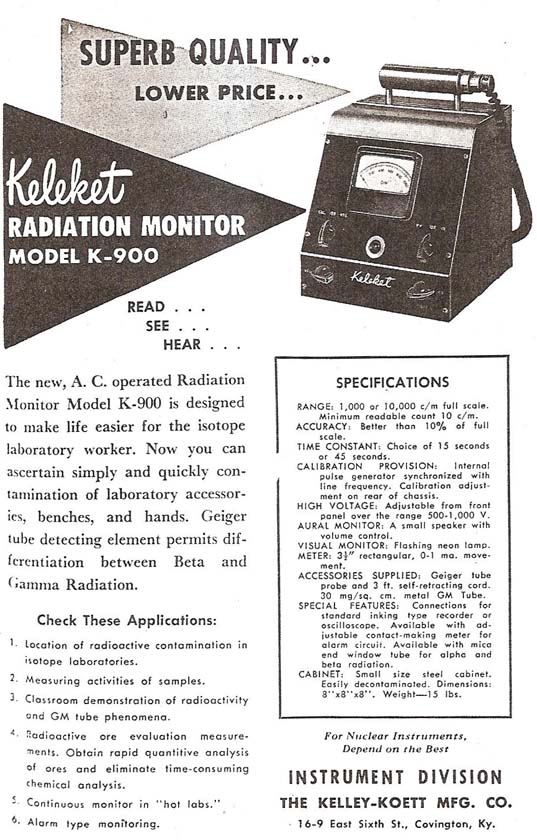
Keleket Model K-900 Ad 1950
The K-900 was introduced in 1950. It was equipped with a thin walled Geiger tube which is sensitive to both beta and gamma radiation. It operates on AC power. It has a flashing neon light and variable volume speaker. Its ranges are 1000 and 10000 cpm. Internal calibration based on line frequency. It has an adjustable volume speaker and flashing neon light. The Geiger tube voltage can be adjusted from 500-1000V. There is a wide slot on one side of the probe that allows beta gamma discrimination. The unit is 8” square and weighs 15 lbs.
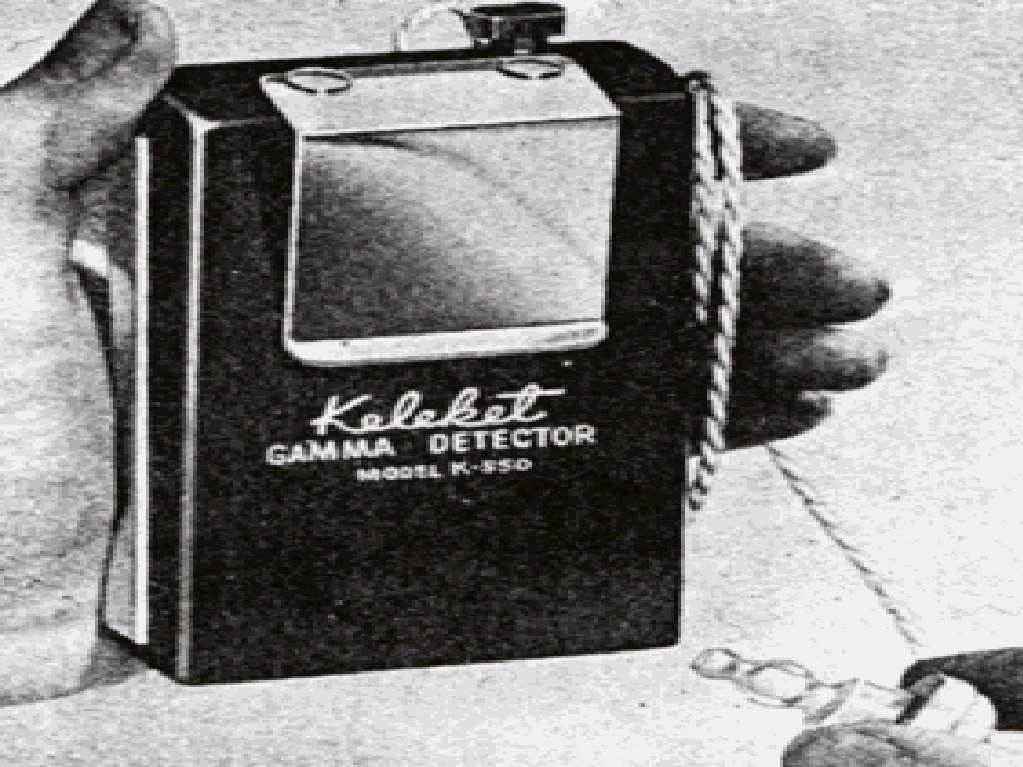
Keleket Model K-550 1950
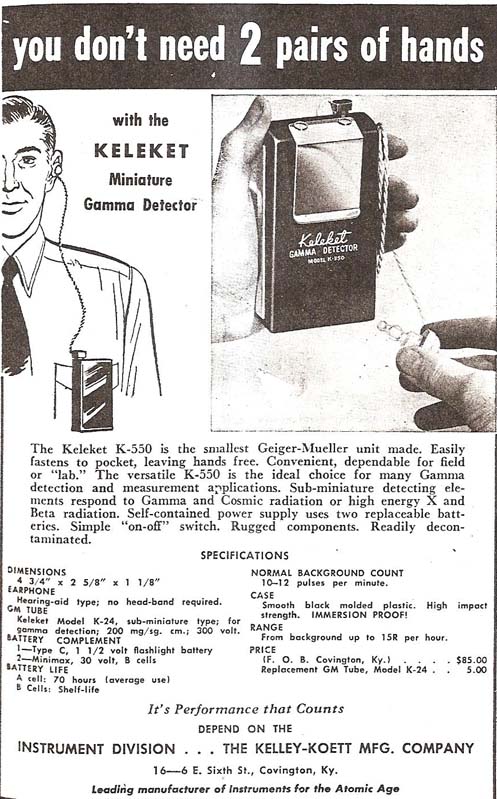
Keleket Miniature Gamma Detector Model K-550 Ad 1950
The Keleket K-550 was sold in 1950. It was the smallest GM unit made. Can be fastened to front pocket. It responds to gamma and cosmic radiation or high energy x-ray or beta radiation. It is 4.75”x2.65”x1.125” and weighs 10 oz. It has a hearing aid type earphone. It has a Keleket K-24 sub-miniature GM tube operating at 300V. It takes one 1.5V and a minimax 30V battery. Normal background is 10-12 pulses per minute. The case is impact strength black plastic. Volume in earphones increases steadily up to 10 R/h. The cost in 1950 was $85.
Keleket also offered the K-700, K-111, and K-180 in 1951 for accumulated radiation exposures for use by medical personnel for symptomatic treatment.
Keleket offered the K-900 and K-281 in 1951 for determine radioactivity in foodstuffs, water and the atmosphere.
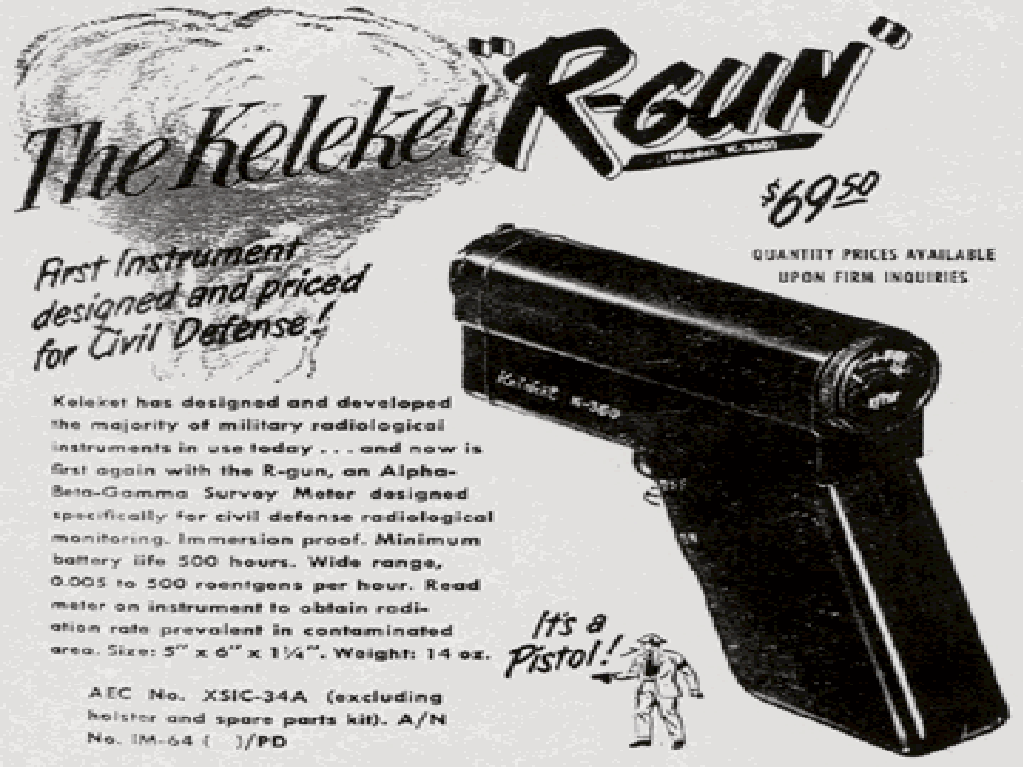
Kelekot K-360 R-Gun 1951
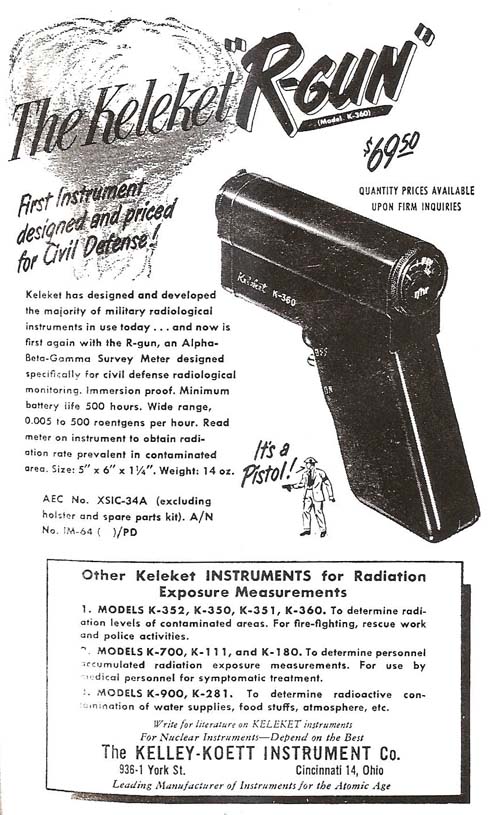
Keleket R-Gun Model K-360 Ad 1951
The R-Gun K-360 was offered in 1951. It was pistol shaped alpha, beta and gamma survey meter. The ad claims that Keleket has developed the majority of the radiation equipment being used by the military. It is immersion proof and has a battery life of over 500 hours. It has a wide range from 0.005 to 500 R/h. The meter is on the end of the gun. The AEC number is XSIC-34A. It comes with a holster. Its also designated AN IM-64/PD for military use. It sold for $69.50 in 1951.
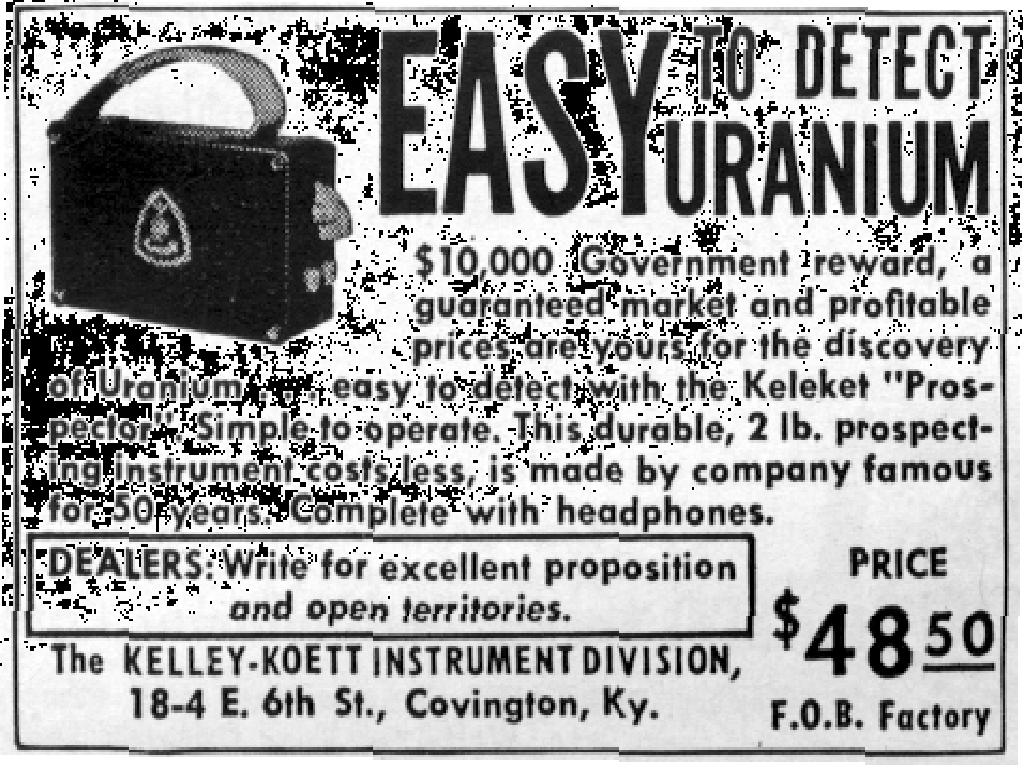
Kelley Keott Model 803 1955
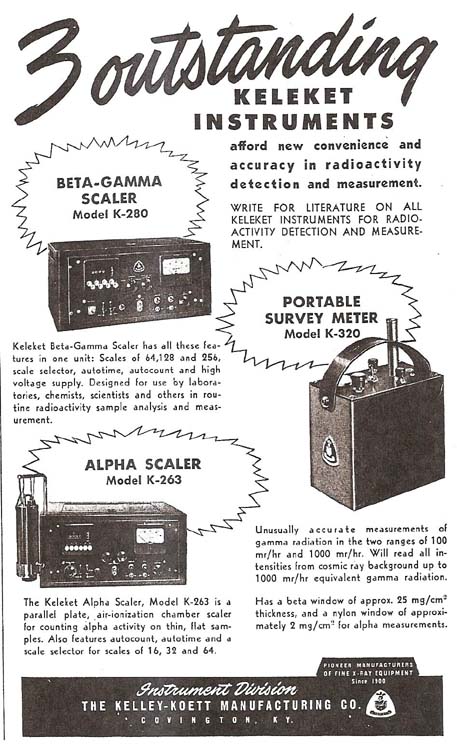
Keleket Ad 1949